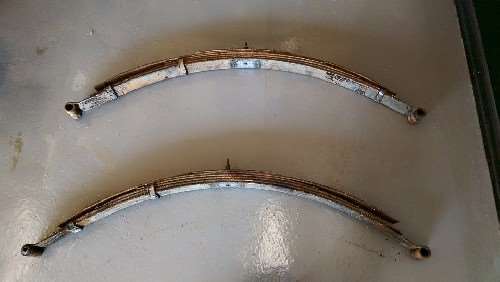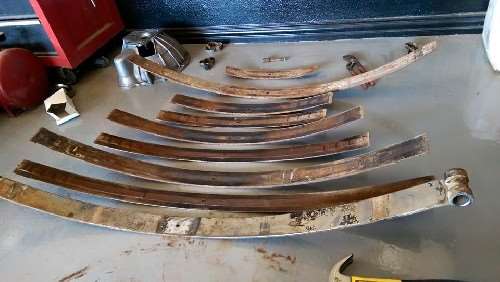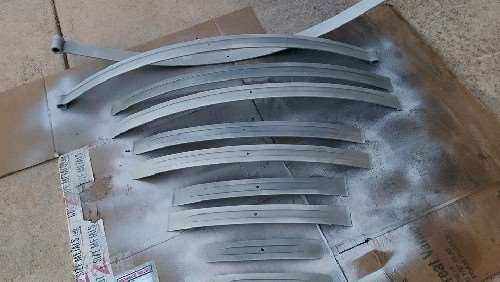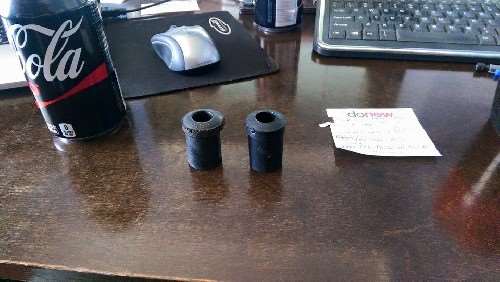|
Re: Packard Radios
|
||||
|---|---|---|---|---|
|
Home away from home
|
Just started the Packard radio in my Project blog, so if there are questions about reconditioning the original radio, this might be useful:
https://packardinfo.com/xoops/html/modules/newbb/viewtopic.php?topic_id=13999&post_id=159812#forumpost159812
Posted on: 2015/4/1 13:30
|
|||
|
||||
|
Re: Richter's '53 Caribbean
|
||||
|---|---|---|---|---|
|
Home away from home
|
Began radio rebuild today, since I finally managed to find a 6V power supply that will work.
For reference, it looks like it pulls at least 2 amps, so if you happen to find a wall plug that's 6VDC, make sure your amps is more than 2. Plugging the positive into the lead with the fuse on it, and negative to the chassis, I was able to get the bulb to light, but no noise from the speaker. Started taking apart the radio, not much on the outside was recognizable, so I was surprised to find a piece of paper nestled safely inside, in perfect condition after 60+ years, with the model number and tube layout for the radio. Remember when people used to be thoughtful like that? I don't. Two screws at the bottom to remove allows the back cover to come off which gives access to the tube compartment, which is where I found the diagram paper. I started by making a list of the tubes on a notepad, and looked them all up athttp://tdsl.duncanamps.com/tubesearch.php Without a tube tester, you can only do a basic test of the filament, so I was interested in finding out which pins were the heater/filament. In my particular set, 6v6GT (GT is Glass Tube, and functionally the same as 6v6, in case you need to replace). So in my set, 6v6GT x2, 6SK7 x2, and 6SA7, the heater/filament is from pin 2 to pin 7 (pin 1 is left of the notch, looking at the bottom, and goes clockwise, to 8 being right of the notch). the 2 6SQ7's are from pin 7 to pin 8. What this means is, like a light bulb, if you put an ohm-meter across the filament pins, you should get low, generally 4-6 ohms, but actual value doesn't really matter, as long as it's not open (tube burned out). 0Z4 or Oz4 I haven't found any info on. I lucked out and all of my tubes tested okay except for one of the 6SQ7s, which was in there so tight that my hand slipped and I threw it across the room. :P The filament actually still measured okay, but you could hear it rattle when you shook it. So add a step, gently shake the tube to make sure you don't hear anything loose. Not too hard though, a vacuum tube is essentially a light bulb. Looking through the back of the chassis, you should see the one wire that goes to the speaker, gently slide it out of the holder, remove the hex screws right around the front lip of the housing (about 10 of these), (and remove the nuts over the posts of the radio) and you should be free to remove the front cover (and the speaker with it). Looking in on this side, you can see the capacitors. They look like crayons that have been left under the car seat for a few years, and are about as useful. They'll all need to be replaced with newer orange drops of comparable value. Unfortunately, due to age and melty waxy goodness, good luck finding out what the values are without a schematic. I've ordered the schematic for this radio, and I'm going to go through my other radio kit to see if I just happen to have a 6SQ7 tube (probably not). Once I have the schematic, I can find the values of all the wax capacitors, and order the correct replacements. Replacement capacitors run between 5 cents and 50 cents a piece. Only the wax capacitors and electolytic capacitors need to be replaced unless there's an obvious issue. Mica caps and ceramics (and resistors) should be good for a lifetime. Generally, it'll cost you less than $10 in capacitors. Once you get them, just go one at a time, cut an old leg, solder a new leg, check and double check you're using the correct value until they're all done. Only electrolytic capacitors have polarity, the wax ones/orange drops you're replacing them with can go in either direction. Electrolytics you have to make sure the new cap goes in with negative on the same side as it comes out. For cosmetics and function: Everything chrome I hit with 000 steel wool and WD40, then buff with a soft cloth, and it made a huge difference. Not exactly show chrome, but much better than it started. Be very careful around the lens of the dial - it's plastic, so steel wool will scratch it by breathing on it. If it was glass it'd be safe. The buttons, they pull out to set the station, so to clean them, I steel wooled the whole assembly first, then pulled each out one at a time, and pushed the neighbor in so I could get the sides. While they're out, put a drop of 3 in 1 oil or other light oil on the arms where it slides out and in, work it back a few times. If it's hard to pull them out, then pull gently toward the volume knob side as you pull out. When working the oil in, I made a little oval, To the left and out, to the right and in, maybe a dozen times each to rub off the corrosion and rub in the oil. I added a drop of 3 in 1 oil to the tuning gear as well, and now everything moves smoothly. I'll update as I work more on this. My end goal is to add a phono input so that I can feed 40's, 50's, 60's songs from an mp3 player, but in such a way that it doesn't interfere with the regular operation of the radio. Guide to pictures: Radio 1 - starting point Radio 2 - Model and Tube Layout diagram from inside the radio Radio 3 - Before closeup of bezel Radio 4 - Before of Bezel Radio 5 - After cleaning Bezel Radio 6 - Before buttons Radio 7 - After buttons Radio 8 - chassis, front (speaker side, with caps) Radio 9 - chassis, front (another angle) Radio 10 - chassis, rear (tube side) Attach file:  (67.37 KB) (67.37 KB)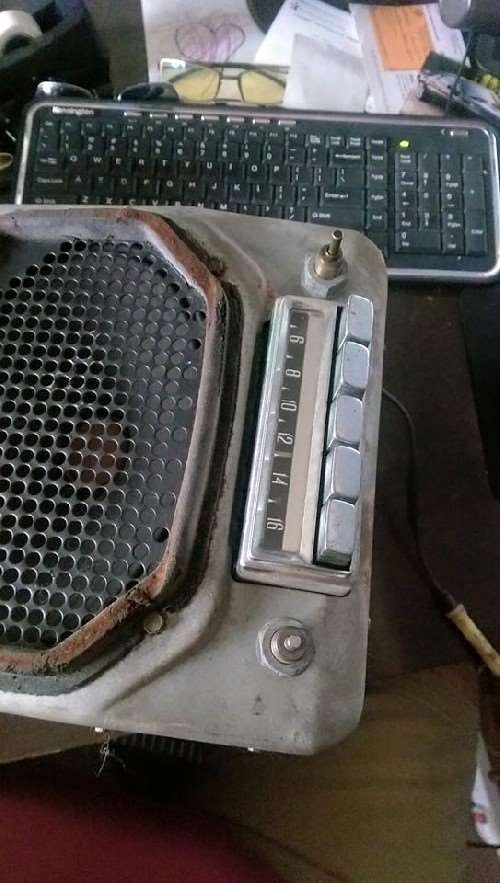  (55.99 KB) (55.99 KB)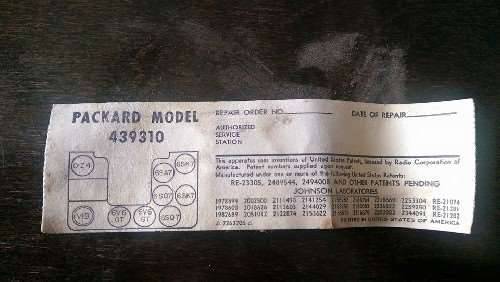  (81.39 KB) (81.39 KB)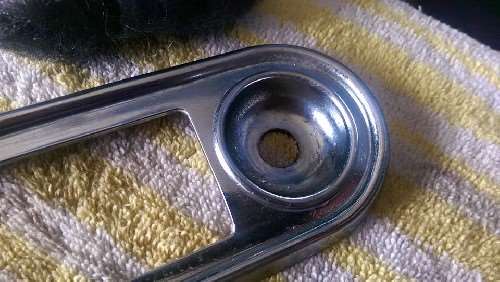  (80.63 KB) (80.63 KB)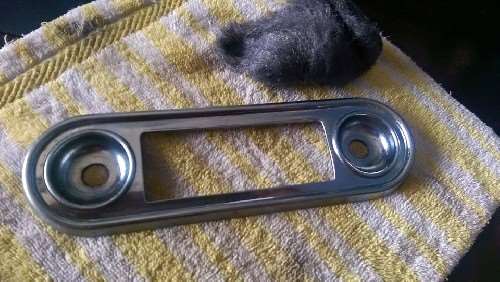  (48.14 KB) (48.14 KB)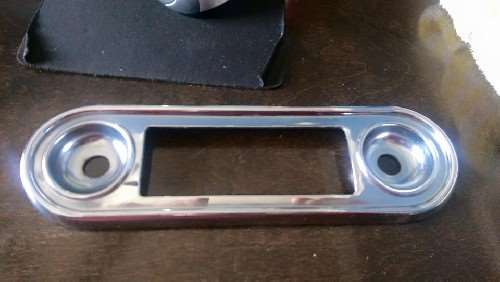  (58.11 KB) (58.11 KB)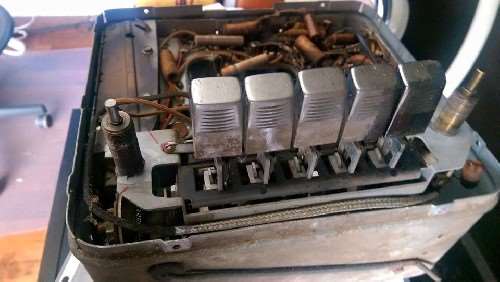  (57.36 KB) (57.36 KB)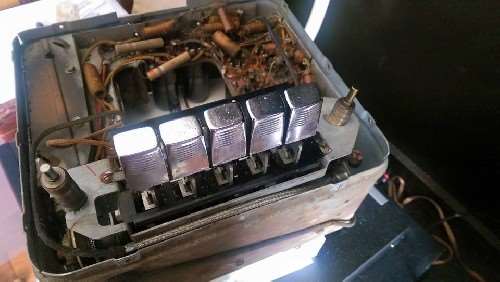  (58.40 KB) (58.40 KB)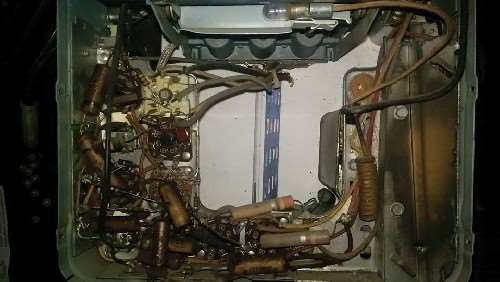  (69.50 KB) (69.50 KB)  (57.91 KB) (57.91 KB)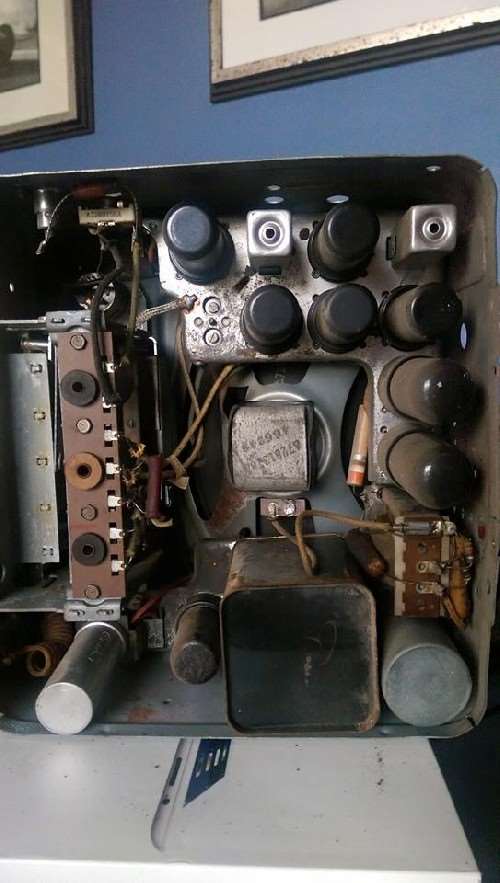
Posted on: 2015/4/1 13:26
|
|||
|
||||
|
Re: Richter's '53 Caribbean
|
||||
|---|---|---|---|---|
|
Home away from home
|
Looks like this says the Convertible and the Sedan share the same dimensions. The donor frame was from a sedan.
But even if it were the Mayfair, the biggest discrepancy is 1/32" of depth and 1/64" of width and thickness (if I'm reading it right). I'm pretty sure that's close enough to work just fine, but also close enough that I might have missed it with the micrometer. The Caribbean frame was rusted almost completely through in several places, and I wouldn't feel super comfortable driving a car with a welded frame, especially with a perfectly good frame right there. Even if it were different, it's not enough different to warrant spending $3000 on a donor car just to rip the frame out, so that it can be 1/32" taller. :) Good information to have though!
Posted on: 2015/3/30 9:25
|
|||
|
||||
|
Re: Richter's '53 Caribbean
|
||||
|---|---|---|---|---|
|
Home away from home
|
The only difference is the frame rails for the X - if there's a difference in the width, or even the thickness of the metal of the side rails that run lengthwise down the car, it's not a difference that I could get to show up on my micrometer. :)
The body itself has an additional square steel reinforcement that runs down the side, but it's welded to the body and bolted to the frame, not the other way around. That's actually why the outriggers are different, is to account for the extra 2" or so square steel support under the body.
Posted on: 2015/3/30 9:03
|
|||
|
||||
|
Re: Richter's '53 Caribbean
|
||||
|---|---|---|---|---|
|
Home away from home
|
Started work on the leaf springs this weekend - almost finished. I've ordered the replacement rebound clips, so they can get all put back together and back on the frame.
I disassembled the springs from the Clipper, which were in great shape, and the Caribbean, which were in less good shape - after deliberating for a bit, I decided to refurb the Clipper springs and use those instead of trusting the much more pitted and corroded Caribbean ones. The Caribbeans have a SLIGHTLY stiffer spring rate, but I'm willing to bet most of the difference has gone out the door with the metal that was lost due to rust. The other bit to make my decision is that Kanter doesn't seem to differentiate between the 51-54 leaf springs at all, on their website, so if I were to buy a new replacement I'd likely end up with the same springs from the Clipper anyway, only probably without the isolators and grooved spring steel that Packard actually used back then. After going over them thoroughly with a wirewheel, I gave them a couple of coats with zinc paint, since zinc helps fight corrosion, and is supposed to have awesome wear characteristics (we'll see how that goes). Now they're reassembled with the isolators, and I'm going to give them a coat of black tomorrow. Also, I left out the helper spring, which is probably something that the clipper owner added when he added the trailer hitch. I'm hanging onto it for now, but likely if the spring rate doesn't work out, I'll just pull the trigger on some new springs rather than add the helper spring back. I have a feeling it'll be fine though. Goal is to have a rolling chassis by the end of April!
Posted on: 2015/3/29 22:26
|
|||
|
||||
|
Re: Richter's '53 Caribbean
|
||||
|---|---|---|---|---|
|
Home away from home
|
New bushings are in - here is the old and new together. The new is maybe 1-2mm less width across the wide part, but it doesn't appear enough to make a difference.
Posted on: 2015/3/27 10:17
|
|||
|
||||
|
Re: 53 327 engine
|
||||
|---|---|---|---|---|
|
Home away from home
|
Quote:
I think there is a procedure described in the FAQ section for sizing photos to post. I transfer photos from my iPhone to my iMac, move them into iPhoto, export them from there in a smaller size to my desktop, and then select them from there to post here. This also allows me to do other edits like orientation and trimming. Not to get off-topic, but the fast answer I use is to upload them from phone to Facebook, then download from Facebook and they're now sized appropriately for posting. On topic - If I'm remembering correctly, I believe the first number in the serial number will tell you what type - something like 1s and 2s for 288s, 3s for 327 5 main and 4s for 327 9 main. That may not be perfect, but it's along those lines. The letter tells you what series/year.
Posted on: 2015/3/24 11:43
|
|||
|
||||
|
Re: Packard Radios
|
||||
|---|---|---|---|---|
|
Home away from home
|
Quote:
I got it to play, but the volume was very very shallow. I did it for my mom. It played long enough to surprise her and she loved it. It even played the old super hard thick records. Shortly after it pretty much doesn't work again. Sometimes I get lucky, but you have to shove your ear next to the speaker to hear it. I'd bet recapping the thing would fix it - there a few guys around DFW that will do it, but it'll probably run you starting at $100 or so. If you can operate a soldering iron, and would be comfortable replacing an ignition switch in an early car, or a radio in a late model car, you can probably do it yourself with no problem, and if you've already replaced the tubes, the caps will probably run you less than $10. The schematic you have should tell you the values of the capacitors. The ones you're interested in are likely big (about the size of a glass buss fuse, or bigger) and covered with wax (they dry out over time), and the key is just to go slow, cut and solder one leg at a time, and make sure you're replacing them with the correct ones. You SHOULD replace the electrolytics, too - that can be a little more complicated because sometimes they're in a big can on top that looks like a metal vacuum tube. They also have polarity, meaning you have to get positive to positive and negative to negative or it doesn't work. The theory is still easy - you clip out the wires going to the 'can' and just replace them with new electrolytics in the chassis where they're hidden, leaving the can up there on top for looks. The only challenge there is getting comfortable enough reading the schematic to figure out which leg of the can goes to which value of electrolytic - not super difficult, but can be a challenge if you're not used to schematics. If it were me (minus having done it before), I'd take a look at the capacitors that are in there and figure out if I'd be comfortable cutting them out one at a time and soldering new ones in - if so, I'd do all the paper caps first (they're almost surely shot.) Then (carefully, that's live voltage, and amplified!) plug it in and see how it does. It may be good enough that you can just leave the electrolytics alone. If it's not, getting the guy to replace 3 or 4 electrolytic caps for you would have to be about half the price of a total recap job. It's all point to point solder, not a circuit board, so you just bend the legs into little hooks, then add a dab of solder so they don't let go. Make sure they don't touch anything they're not supposed to, do one at a time, and it's hard to mess up. Like soldering in a new turn signal socket. Also, I'd offer to take a look at it for you, but with my two year old running around, I don't even have the time to work on my own projects, without taking anyone else's on. :D I'll be happy to answer any questions for you, though, if you decide to take a shot at it yourself. edit: Oh, and if you decide to take it somewhere, see if you feel comfortable enough removing the chassis from the case. If you look in behind the dial where the volume and tuning knobs are, you'll probably figure out the radio itself is in a metal case about the size of a shoebox, with plugs to connect the record player, speaker and probably antenna as well (some of those are built into the case though). It'll be a heck of a lot easier to transport without having to move the furniture piece, which already looks in good condition. :) edit: Here are some awesome sites to explain what I mean - the same ideas apply to the radios in the Packards as well - at least in my '53, the radio is totally standalone, just like the chassis in the big console radios - as long as you have 6v power instead of wall power, then you can run it on your desktop, and it'll recap and retube just the same. http://www.antiqueradio.org/recap.htm http://www.justradios.com/captips.html
Posted on: 2015/3/21 22:59
|
|||
|
||||
|
Re: Packard Radios
|
||||
|---|---|---|---|---|
|
Home away from home
|
Yep! In fact, both radios actually have the switches already. Disconnecting that Intermediate Frequency (IF) section just gets rid of a lot of inductive noise from unshielded source wires.
Basically you'd get a low hiss when playing phono, but if you turned it up super loud and you were on-station, you'd figure out that hiss was actually the radio station being picked up by the inactive network - so the radio station you were tuned into was still playing, just wasn't getting amplified. Disconnecting that wire from the IF tube in the Zenith just cut all power to that section, so the silence is clear as a bell now. Honestly there was probably a resistor to ground or something that I could replace, but it was easier to disconnect the wire than to find which one. When I say I isolated the wire, I just mean I wrapped the plug end in electrical tape so that it won't short anything else out in the radio from being loose - all you have to do is unwrap the tape and plug it in - takes about a half a minute on the Zenith. In the Packard radio, you could surely just add a Single-Pole switch there, and use that to isolate your IF.
Posted on: 2015/3/21 22:44
|
|||
|
||||

